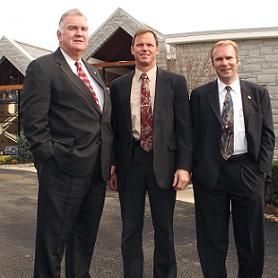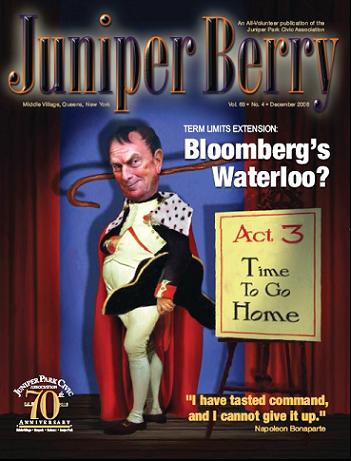Every so often, beautiful church-like bells ring through the tree-lined streets of Middle Village, Glendale and surrounding lands. Reminiscent of a simpler time, the chimes echo not only a peaceful tone but also the assurance that All Faiths Cemetery, one of the area’s largest and well-known memorial parks, is keeping pace with the demands of change.
As the area has grown and matured, so too has the cemetery. Under the direction and leadership of current President and CEO, Dan Austin, Sr., the cemetery has drawn up new and innovative plans designed to maximize the usage of space, meeting current and future economic needs while at the same time keeping the desires of the surrounding community in mind.
“Community is very important,” says Austin speaking from his second floor office overlooking Metropolitan Avenue. Austin’s roots in our community run deep, as he grew up in Glendale and is a graduate of P.S. 88, Grover Cleveland High School and John Jay College of Criminal Justice. With a year-round complement of 20 union men, a summertime workforce of 40 to 45 workers and an administrative staff of 11 people, Austin oversees 225 acres or property. More than 540,600 total interments have taken place along 19 miles of roadway inside the borders of All Faiths Cemetery since its founding in 1852. The property, with its rolling hills, cobblestoned streets and mausoleums is picturesque and the chosen site for many movie and television productions.
“We’re always available,” said Austin, “We want people to come here and if they are unable to get here on their own, we’ll pick them up.” It’s one of the programs Austin established whereby senior citizens who cannot visit their departed loved ones at the cemetery due to some hardship or inability to travel are picked up, and then after their visits are then transported back to their homes. Another program helping those less fortunate allows for the interment of indigent people free of charge.
“Everyone here believes in the sanctity of life,” said Austin who makes it a point to surround himself with people who hold similar values. Along with Executive Secretary Carol Brzynski who handles much of the administrative duties for Austin, there’s Jim Goulet, Director of Operations and Drew Nelson, Director of Engineering, who are key people and examples of the kinds of individuals Austin entrusts with the nuts and bolts of the cemetery. “Providing a good service and helping people,” says Nelson, a former Commanding Officer in the NYPD Harbor Unit. “We’re helping people at their neediest times.” Goulet, also raised in Glendale and now residing in Middle Village, mentions that Austin hired him in 1990 as a grave digger and cherishes his part in the renovation of the General Slocum monument in 1992. “My mission is to keep this historical place pristine and to preserve the past so that future generations will learn from it,” says Goulet.
That education of future generations is in good hands as All Faiths is currently involved in the preservation of Saint Saviour’s Church, with Dan Austin Jr., a retired NYPD detective with an education as an architectural engineer and
historical preservationist, working on the project. Built in 1847, the church was draped in controversy stemming from the problems associated with the overdevelopment of Queens and the need to preserve history. The historically rich church was left without a home and plans for its destruction were imminent. Were it not for members of the Juniper Park Civic Association stepping in to save it from demolition, it would have been lost forever. Instead, it was uprooted from its original site earlier this year and is now dismantled and stored in tractor trailers and awaiting the preparation of its future home at All Faiths.
With money allocated by Borough President Helen Marshall, State Senator Serf Maltese and Assemblyman Andrew Hevesi, as well as private contributions and grants from the New York Landmarks Conservancy, more than $300,000 of the estimated two million dollars required to complete the relocation project has been either collected or pledged. For its part, All Faiths has secured land for the church; land which is a vanishing and precious commodity in Queens.
The property All Faiths has allocated will be located on 69th Street, just north of Metropolitan Avenue. “When the funding is completed, St. Saviour’s will be transported and reassembled on the grounds of All Faiths Cemetery, and will have its own entrance from the street,” said Austin. Getting the most use out of resources is what Austin has continually strived to achieve since taking the helm in 1990. He realized that more could be accomplished within the property, namely at the Trinity Mausoleum located on the south side of Metropolitan Avenue where the old church was situated. “It wasn’t marketed in an aggressive manner,” said Austin, who developed strategies to not only have all 615 crypts sold, but planned new projects such as the Eternal Light and Light of Hope Mausoleums. The former was built in 2001-2002 and the latter opened in 2007. Together, they hold over 4,500 crypts and niche spaces for cremated remains as well as two private family rooms. Although 75% of the Eternal Light mausoleum is now filled, Austin contends that All Faiths has plenty of space for future interments. “We have room to inter or entomb two hundred thousand more bodies plus the interment of an unlimited amount of cremation remains.”
All Faiths also had a big hand in the restoration and beautification of the Pullis Farm Cemetery in Juniper Valley
Park, the Remsen Cemetery in Forest Hills and the constructing of stone planters at Christ the King Regional
High School. The cemetery has proven itself to be a partner in the community it serves.
As for those pealing bells, they had a very specific function years ago before cell phones came on the scene. “They were used as a means of communication,” said Austin, who told of how the chimes would ring out to alert cemetery workers of the location of an arriving funeral. “If a funeral came in and it was at section one, block four, and grave number three, it would ring once for the section, four times for the block and three times for the grave, and then all the men would gather to the location.”
Austin says that it was during a board meeting in 1999 that one board member had the idea of bringing back this old tradition. In response, and to honor fellow board member Bill McCaffrey who suffers from ALS and who himself had donated resources to the cemetery, the seven board members contributed $1,000 apiece in order to once again hear the bells at All-Faiths. Today, the bells are electronic and can be utilized if a family desires a song to be played at the funeral of a loved one. Austin’s plans regarding Saint Saviour’s, community assistance or new mausoleum projects would be of little value without the one attribute he possesses most – the respect he shows for what has been placed in his care as he continually refers to those interred at All Faiths as “people” and not merely “bodies.”
“I have eighteen of my own relatives interred here so we treat everyone like I would want my relatives to be treated,” he says. When thinking of Austin and the employees at All Faiths, a statement I heard years ago seems to ring true – as true as those bells at All Faiths. “If you respect the dead, you’ll respect the living.”




